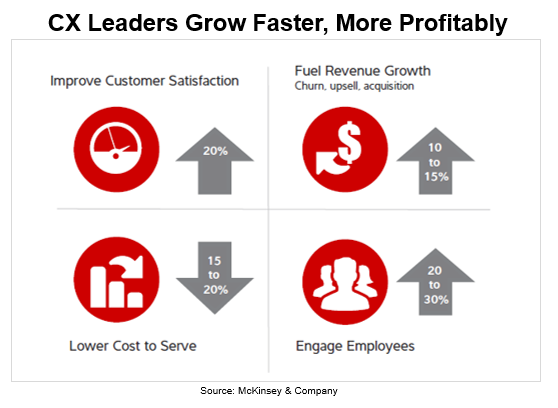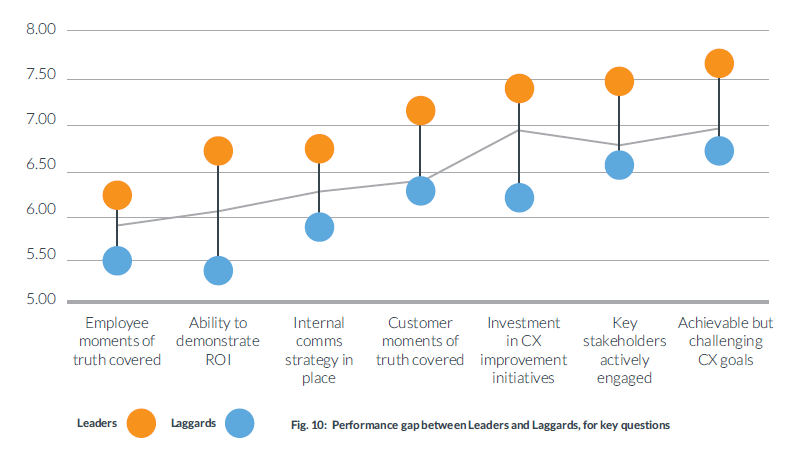Welcome to 2020 and the start of a new decade! CX dominated the conversation in the past 10 years; it will be interesting to see what happens next.
In recent years one of the big topics has been how to get more bang for the CX buck. CX success stories are remarkably few and far between. Naturally we’d all like to know what actions will lead to the coveted “CX leader” position where McKinsey finds benefits any CEO would want.

If you’re not sold on chasing the pot of gold at the end of the CX rainbow, do a search on “benefits of CX leadership” then come back to finish this post in a day or two when you’re done.
CX Success Drivers
I’ve still not seen a real “predictive” model that identifies factors that drive CX success. By predictive, I mean a study done over time to analyze how changes in dependent variables (potential drivers) lead to future improvements in CX success (measured by customer sat improvements or ROI).
What we have instead are many studies done at one point in time that show correlations. Unfortunately, correlations don’t prove cause and effect. So, it’s possible for a CX study (like CustomerThink’s, for example) to conclude that CX success is related to choice of strategy (focus on journeys rather than touchpoints) and effectiveness of key practices (Voice of Customer, for starters).
While it’s reasonable to think that these “drive” CX success, it’s possible that the correlation means the opposite — companies achieve CX success then spend the money to improve their strategies and practices.
The State of CX is “Depressing”
I share this as a preamble to discussing a Confirmit “State of CX” report aptly titled “Time for a Revolution: How to Beat the CX Slump.” That’s precisely the problem that CX professionals must solve — if they want to keep their jobs.
You can get all the details here (registration required to download full report).
I really liked the pull-no-punches style of the report, written by Engage Business Media for Confirmit. For example, the report concludes from a survey of 800 CX professionals:
For the third year in a row, we have surveyed CX professionals from around the world, and the news is pretty depressing. The gulf between those programs that are delivering on the promise of business success and those that remain just a “feedback program” is getting wider. This is a concern, but also a great opportunity for those organizations that can get it right. If you ever wanted to differentiate yourself on experience, the time is now!
The report presents three “catalysts” for improving CX success:
- Raise one rallying cry
Feedback should be combined with other business data and human stories to motivate people to change. - Focus on better decisions
Instead of obsessing about NPS improvements, empower employees to make better decisions every day. - Prove your worth
To get more CX investment, show how CX programs are delivering business value now.
My take: YES! All of these actions will help improve CX success. Especially that last one. My feeling is that a lot of good CX work is not rewarded with more investment because CX pros lack internal selling skills. The report highlights business acumen as a key skill (emphasis mine):
Of the skills we asked about, the one to focus on here is business acumen and a commercial view. Here, 47% of Laggards and 57% of Leaders consider business acumen to be a key skill for the future – and the second highest after storytelling. It’s the skill that 37% of our audience believe they have sorted already, the highest of any of the skills. The 55% who say it is emerging, and the 7% who don’t have that skill at all within the CX team need to make a push here. Ultimately, all our CX efforts have to benefit the business – and we need to be able to prove the impact.
The State of CX, per Howard Lax
I had a great chat about the state of CX with Howard Lax, Principal Director, Customer Experience Consulting at Confirmit. Howard is a longtime expert in customer loyalty and, much like the report, is refreshingly candid. Here’s a summary of my interview:
How as the CX industry changed in recent years?
Howard says there’s more focus on implementation (from talk to walk), but senior executives are “still doing too little walking.” Senior CX leadership is too often in name only and doesn’t provide the necessary “force” to move the program.
On a positive note, there’s been great progress on ability to personalize experiences, although this has been undercut by recent issues with privacy/security.
Technology has improved a lot, especially with advances in AI and self-service. But empathy and human touch are still critical. (For more on this, read Howard’s excellent post Emotional Bonds: The Secret Elixir in CX.)
Is CX succeeding?
Technology has enabled companies to do, at scale, what we could only talk about 20 years ago.
But this hasn’t translated into a lot of CX success stories. Perhaps in part because customer expectations are rising. Doing “ok” and keeping pace is certainly better than falling behind.
Becoming a CX leader is difficult because many companies are chasing the same strategy. Some can and will continue to succeed based on product, quality, or price.
Who sponsors CX?
Sponsorship is moving away from market research to line operations — such as store management or sales operations.
Customer service and contact centers continue to be a “big force.”
Are CX jobs at risk?
Yes! If the economy slows, senior leaders will cut anywhere that ROI is questionable.
Howard says you “don’t need a Ph.D. in economics to show ROI, and finds it “astonishing” that CX pros don’t link their work to business outcomes more systematically. Me too.
Trying to prove how much a one-point improvement in NPS increases revenue is “way too abstract.” Instead, CX pros should focus on making the case at an intermediate level, such as showing more loyal customers generate more business value.
CX Leaders = Spending Faster
The research defined a “Leader” as “the elite 16% of CX teams who expect significant increase in investment next year.”
Wait, what?
My first reaction was this is backward. I usually see CX leaders defined as:
- Higher levels of, or increases in, customer satisfaction
- More mature in execution of CX practices
- Higher levels of business value/ROI
As CX programs get up and running, a successful pilot could lead to a big increase in spending the next year or two, maybe more. For example, a $100K investment in year 1 is followed by $500K in year 2 and then perhaps $1M in year 3.
But even if the CX program is showing good results, I don’t see how budgets will keep getting significant increases. That may explain why the percentage of “Leaders” dropped from 22% in 2018, to 16% in 2019.
The rationale I received was that spending increases are a “pragmatic measure of the business success that programs are driving.” Basically, it’s easier to secure future investment for a program that’s generating ROI. Furthermore, the “vast majority” of respondents in the study have more mature programs, so the rapid increases typically seen in early years didn’t distort the findings.
Okaaay, but why not just define a leader as one that delivers ROI? That’s what CEOs want to see, and ROI is what is driving future investment. The ROI story is not so depressing — for a few industries anyway.

Giving the rest of the report a careful read, the findings are indeed very consistent with other CX leader/laggard studies I’ve seen. Like this chart which finds “Leaders are much more satisfied with effectiveness of their program.”

So, it appears that future spending increases are a decent indicator of CX leadership.
CX pros, the key message of this report appears to be if your company is not willing to ramp spending next year, not enough business value is being delivered today. And that could mean a depressing future for your career.



